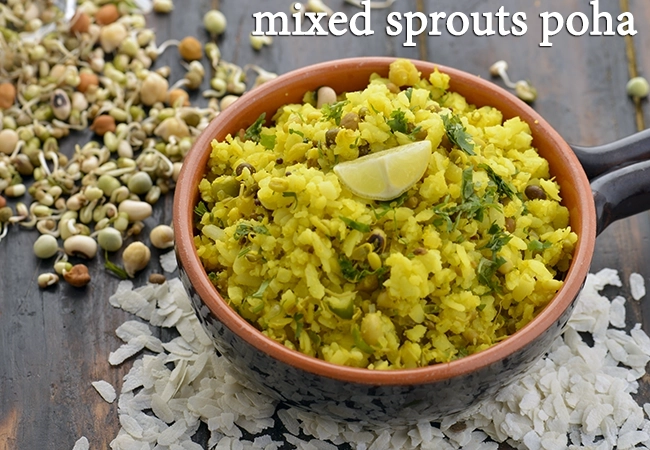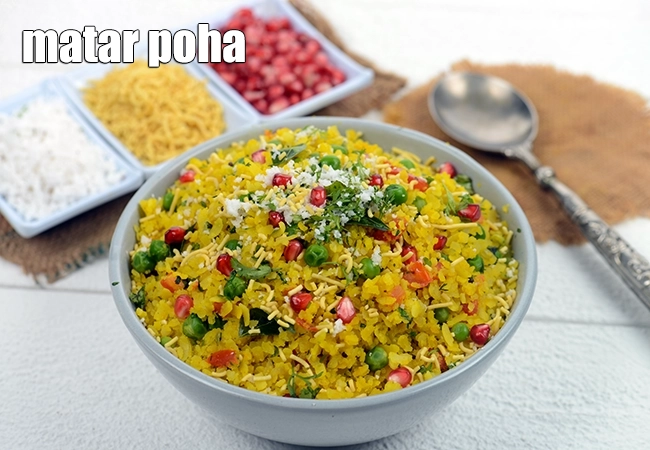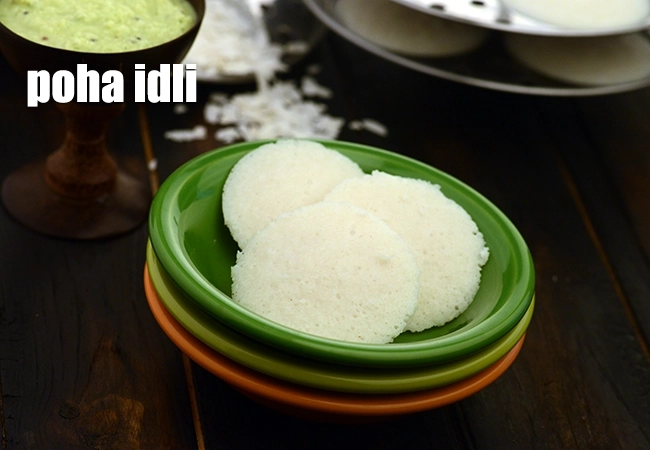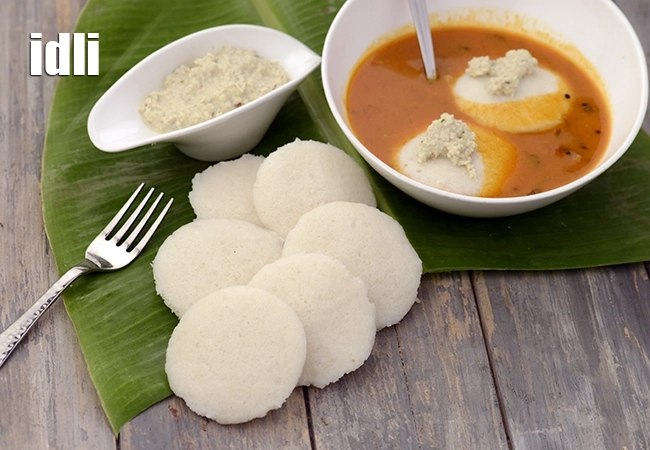beaten rice

Table of Content
What is Beaten Rice, Poha, Rice Flakes?
Poha is nothing but rice that has been parboiled, rolled, flattened and then dried to produce flakes. The flakes come in different thicknesses depending on the pressure used in the flattening process. Rice flakes are small, very light, about 2mm long, flat and greyish white in colour. They have uneven edges and a rough texture. Rice flakes have no particular aroma and a bland gentle taste. Depending on the method of cooking, they can be soft or crunchy.
The rice flakes (poha) are capable of absorbing a large volume of liquid when used in various recipes, and hence imbibe flavors well. They are very popular in Asian cooking, but in Western countries they are more often used commercially in the production of cereals and rice snacks.
Also Known as
Poha, Powa, Flattened rice, Pressed rice, Flaked rice
How to select Beaten Rice, Poha, Rice Flakes?
• Both medium and fine flakes are readily available in the market, so buy the one suitable for your recipe.
• Look inside the bag to make they are not too powdery, though some crumbling is inevitable.
How to use Beaten Rice, Poha, Rice Flakes?
• Rice flakes are very easy to cook and can make a meal in minutes. First wash the beaten rice in water and then soak for 10 minutes. Strain using a strainer and use as required to make sweet or savory snacks. Maharashtrians love Kanda Poha or Onion Poha and Quick Batata Poha
mixed sprouts poha recipe | healthy sprouts poha | breakfast poha

3. matar poha recipe | green pea poha | healthy matar poha |

• Poha, made from rice flakes, is an easy-to-cook, light and nutritious snack that is often had for breakfast or brunch.
Poha is put in tea and then has as Tea Poha. Try it.
• During Ganesh Chaturthi, at midnight we put Poha in Milk and offer it to God as a Prasad or Bhog.
• When garnished with coconut, fresh tomatoes and cilantro, the vibrant red, green and white against the brilliant yellow of the turmeric-infused poha never fails to excite your taste buds. While poha tastes just as good with curds and pickles, you can add extra zing to it by serving with Mint-Coriander Chutney!
• Rice flakes can be used for preparing soft-cooked, energy-packed weaning food.
• It can also be toasted and seasoned to make chiwda. A jar full with Poha Chivda or Jada Poha Chivda
• Rice flakes are used to make creamy puddings and savory bakes too.
• Poha may be eaten raw like cereals, mixed with milk or yoghurt and fruit, or boiled like oatmeal.
• Poha is used by South Indians to make Idli & Dosa Batter, Idli and Dosa.
poha idli | south indian poha idli | aval idli | soft poha idli | poha idli with fermentation

• Add poha to your gravies; it will act like corn flour to thicken the food.
• Poha patties can also be made by soaking poha and binding it with potatoes, chillies and coriander. Roast it or fry it, and enjoy with mint chutney or ketchup.
• An exquisite snack can be prepared by immersing the rice flakes in cold water, drying them, and then preparing it like a pulao with nuts, raisins, black pepper, green chillies, salt and sugar to taste.
• When one is down with fever or an upset tummy, some rice flakes can be immersed in bowl of water, flavoured with lime juice, salt, sugar and a little black pepper, to make a comfort food.
• Beaten rice can be used to make a variant of the famous ‘curd rice’ or ‘bagala bath’ so popular in south India. Soak the beaten rice in water and drain. Mix curd and salt to it, and serve with mango or lime pickle.
• Raw or slightly toasted beaten rice can be mixed with jaggery and grated coconut, allowed to stand for a few minutes (not more) to soak in the flavours, and then served. This is often made as a quick neivedhya, when no elaborate sweets or foods have been prepared for offering to God after puja.
How to store Beaten Rice, Poha, Rice Flakes?
• Store in a dry airtight jar, and use within three months.
Health Benefits of Poha, Beaten Rice, Rice Flakes
1. Plentiful of Carbohydrates : Most people prefer eating poha for breakfast. The reason behind it is its high carb count. A cup of poha provides approx. 46.3 gm of carbohydrates. A single serving is enough to satiate you and keep you full for hours.
2. Valuable Source of Iron : The high iron count (2.67 mg in a cup) of poha is because of its production process, which involves passing rice through rollers. The rice along with flattening out also retain some of the from these iron rollers. Iron is a key element in maintain the levels of hemoglobin and RBC (Red Blood Cell) count. To enhance the absorption of iron, you can simple squeeze some lemon juice on poha or accompany the delicacy made with beaten rice with a vitamin C rich fruit.
3. A Good Probiotic : Though surprising it may sound, but the during the process of soaking the grain undergoes a partial fermentation. This retains the probiotic bacteria which are beneficial for gut and assist in digestion.
For complete Health Benefits of Beaten Rice, Poha read this article.
Nutritional Value of Poha (beaten rice)
1 cup of poha is about 60 g
RDA stands for Recommended Daily Allowance.
Energy - 207 calories
Protein – 3.96 g
Carbohydrate – 46.3 g
Fat – 0.72 g
Fiber – 0.42 g
Vitamins:
0.12 mg of Vitamin B1 = 10% of RDA (about 1.2 to 1.6 mg for men)
0.03 mg of Vitamin B2 = 2.1% of RDA (about 1.4 to 1.9 mg for men)
2.4 mg of Vitamin B3 = 15% of RDA (about 16 to 21 mg for men)
Minerals:
60.6 mg of Magnesium = 13.57% of RDA (about 350 mg)
142.8 mg of Phosphorus = 6.25% of RDA (about 600 mg)
92.4 mg of Potassium = 5.13% of RDA (about 4700 g)
2.67 mg of Iron = 13.35% of RDA (about 20 mg for women)
10.9 mg of sodium

thick beaten rice
The rice flakes come in different thicknesses depending on the pressure used in the flattening process. Thick poha does not get mushy soon on soaking like the thin variety of poha. As per the recipe requirement you can toast, fry or soften the thick poha.
Uses of thick beaten rice.
idli recipe | idli batter recipe | South Indian style idli | soft idli |


Related Recipes
How To Make A Perfect Dosa Batter
Batata Poha, Quick Kanda Batata Poha, Aloo Poha
More recipes with this ingredient...

Related Glossary
Follow US
Recipe Categories
- Vitamin B12 Cobalamin Rich Recipes 33 recipes
- Low Calorie, Weight Loss Indian Recipes 421 recipes
- Low Cholesterol Indian Recipes 308 recipes
- Healthy Indian Breakfast 373 recipes
- Indian Diabetic recipes 560 recipes
- Indian Pregnancy recipes 461 recipes
- Zero Oil Indian Recipes 133 recipes
- Iron Rich Indian recipes 268 recipes
- Healthy Indian Acidity recipes 137 recipes
- Healthy Sabzis 108 recipes
- Indian Healthy Veg Snack 276 recipes
- Healthy Heart Recipes 415 recipes
- Healthy Veg Indian Soups 74 recipes
- Calcium Rich Indian 373 recipes
- High Blood Pressure Indian Recipes 103 recipes
- Healthy Indian Salads Recipes 137 recipes
- Low Carb Indian Diet, recipes 163 recipes
- Hypothyroidism Diet 63 recipes
- Arthritis Diet 68 recipes
- High Protein Indian recipes 95 recipes
- Vitamin K Diet 42 recipes
- Fatty Liver Diet 39 recipes
- PCOS 136 recipes
- Gluten Free Veg Indian 197 recipes
- High Fiber 328 recipes
- Indian Cancer Patients 275 recipes
- Jaundice Diet 45 recipes
- Sprouts 61 recipes
- Typhoid 43 recipes
- Irritable Bowel Syndrome (IBS) 23 recipes
- Kidney Stone Diet 10 recipes
- Home Remedies 213 recipes
- Senior Citizen 195 recipes
- Healthy Indian Drinks and Juices 213 recipes
- Diet for Dialysis 10 recipes
- Gout Indian Recipes 17 recipes
- Potassium Rich 80 recipes
- Vegan 195 recipes
- Indian recipes to treat Vomiting 8 recipes
- Forever Young Diet, Anti Aging Indian Diet 255 recipes
- Antioxidant Rich Indian 445 recipes
- Vitamin B1 Rich Indian Foods, Recipes 101 recipes
- High in Omega 3 Fatty Acids 32 recipes
- Zinc Rich Foods 55 recipes
- Vitamin A Rich, Beta Carotene, Retinol 89 recipes
- Malaria Diet 19 recipes
- Magnesium Rich 94 recipes
- Healthy Indian Dinner 85 recipes
- Vitamin C Rich Indian recipes 118 recipes
- Low Veg Glycemic Index 86 recipes
- Lower Blood Pressure Salads 8 recipes
- Healthy Indian Lunch Recipes 29 recipes
- Lactation 25 recipes
- Vitamin E Rich 51 recipes
- Hyperthyroidism Diet 47 recipes
- Vitamin B3, Niacin Rich 41 recipes
- Post Surgery Diet 42 recipes
- Selenium 27 recipes
- Phosphorus Rich Indian Recipes, Foods 74 recipes
- Lower Blood Pressure Desserts Sweets 14 recipes
- Copper 15 recipes
- Foods Rich in Vitamin B2 Riboflavin 22 recipes
- Vitamin B6 Diet 36 recipes
- B Vitamins 231 recipes
- Vitamin B9 Rich Folate 50 recipes
- Marathoners, Endurance Athletes, Triathlete 225 recipes
- Manganese Diet 32 recipes
- Thalassemia 18 recipes
- Detox Water, Fruit Infused Water 42 recipes
- Lactose Free Dairy Free 22 recipes
- Omega 6 Fatty Acids 32 recipes
- Phytonutrients 51 recipes
- Chronic Kidney Disease Indian recipes 12 recipes
- Selenium1 0 recipes
- Quick Snacks / Quick Starters 385 recipes
- Quick Breakfast Indian 131 recipes
- Quick Sabzis 117 recipes
- Quick Rotis / Parathas 46 recipes
- Quick Indian Sweets 139 recipes
- Quick Stir-Fries 51 recipes
- Quick Vegetarian Indian Soups 72 recipes
- Quick Chutneys 67 recipes
- Quick Vegetarian Rice, khichdi Recipes 56 recipes
- Indian Snacks Under 10 Minutes (Quick Veg Recipes) 44 recipes
- Quick Indian Dips, Gravies & Sauces 105 recipes
- Quick Veg Indian Pizza 17 recipes
- Quick Veg Pasta 25 recipes
- Quick Pickles / Aachar 25 recipes
- Quick Dals / quick Kadhis 29 recipes
- Snacks under 5 minutes 33 recipes
- Quick Healthy Recipes 43 recipes
- Quick Pressure Cooker 46 recipes
- Quick Desserts 47 recipes
- Quick 3 Ingredients 63 recipes
- Quick Indian Desserts 20 recipes
- Quick 4 Ingredients 41 recipes
- Quick 5 Ingredients 42 recipes
- Kids Tiffin Box 319 recipes
- Recipes for Toddlers (1-3 Years) 32 recipes
- Sweet Recipes for Kids 456 recipes
- Recipes for Baby (10 to 12 Months) 17 recipes
- Quick Indian recipes for Kids 72 recipes
- Indian Breakfast Recipes for Kids 192 recipes
- Recipes for Weaning (8 to 9 months) 22 recipes
- Healthy Foods for Kids 196 recipes
- Snack Recipes for Kids 619 recipes
- Recipes Kids can make 36 recipes
- Kids After School 794 recipes
- Kids Jar Snacks 66 recipes
- Finger Foods for Babies, Toddlers and Kids 76 recipes
- Kids Weight Gain 43 recipes
- Kids Wraps and Rolls 23 recipes
- Kids Veg Pasta 27 recipes
- Kids Brain Boosting 68 recipes
- Protein rich food for kids 71 recipes
- Recipes for Weaning 15 recipes
- Kids Pizzas 30 recipes
- Babies, Toddler and Kids Iron Rich Foods 31 recipes
- High Fiber Foods for Kids 39 recipes
- Kids High Energy Indian Foods 103 recipes
- Kids Noodles 37 recipes
- Kids Calcium Rich Indian recipes 92 recipes
- Babies recipes, 6 to 18 months 34 recipes
- Kids Recipes for Increasing Immunity 10 recipes
- Kids Weight Loss 58 recipes
- Teething Recipes for Babies 10 recipes
- Cereals and Pulses for 8 to 9 months Baby 8 recipes
- Weaning foods at 7 months 12 recipes
- Indian Teen 315 recipes
- Starters / Snacks 2138 recipes
- Indian Breakfast Recipes 819 recipes
- Main Course Recipes 925 recipes
- Indian Salads 385 recipes
- Indian Desserts , Sweets 985 recipes
- Indian Soups 249 recipes
- Indian Beverages, Indian Drinks 483 recipes
- Indian Dinner 903 recipes
- Indian Dinner1 0 recipes
- Indian Lunch 829 recipes
- Side Dishes 449 recipes
- Indian Travel Food 433 recipes
- Indian Barbeque1 recipes 22 recipes
- Frozen Foods, Indian Freezer Recipes 67 recipes
- Whole Wheat Recipes 56 recipes
- Indian Comfort Foods 212 recipes
- Dinner Menus 56 recipes
- Easy Indian Veg 70 recipes
- Innovative Indian Recipes 27 recipes
- No Cook Indian 37 recipes
- Advanced Recipes 10 recipes
- Cakes with Eggs 13 recipes
- Microwave 229 recipes
- Oven 619 recipes
- Indian Steamer Recipes 102 recipes
- Kadai Veg 407 recipes
- Indian Barbeque Recipes 43 recipes
- Sizzler tray 15 recipes
- Mixer 566 recipes
- Pressure Cooker 315 recipes
- Tava 647 recipes
- Non-stick Pan 1393 recipes
- Indian Freezer recipes, meals 57 recipes
- Appe Mould 18 recipes
- Pan 223 recipes
- Non Stick Kadai Veg 203 recipes
- kadai Indian 150 recipes
- Refrigerator 176 recipes
- Waffle Indian recipes 6 recipes
- Handi 12 recipes
- Juicer and Hopper 65 recipes
- Grill 31 recipes
- Toaster 21 recipes
- Gas Toaster 8 recipes
- Steam 72 recipes
- No Cooking Veg Indian 335 recipes
- Vegetarian baked Indian recipes 380 recipes
- Boiled Indian recipes 129 recipes
- Deep Fry 260 recipes
- Indian Tawa 265 recipes
- Shallow Fry Indian 25 recipes
- Microwave1 172 recipes
- Saute 273 recipes
- Indian Pressure Cooker 171 recipes
- Stir-fry 101 recipes
- Roasting 0 recipes

















